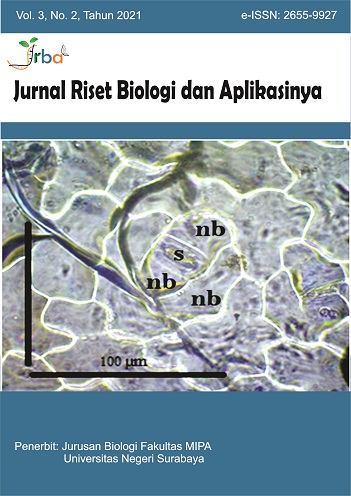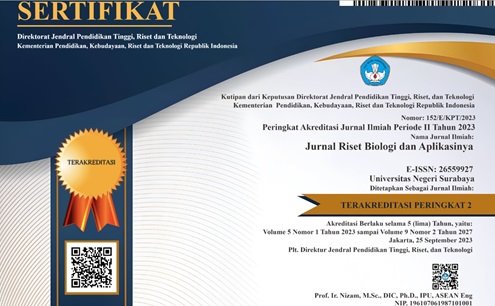Optimization of Various ITS rDNA Amplification Protocol of Yeast Isolated from Giant Honey Beehives (Apis dorsata)
DOI:
https://doi.org/10.26740/jrba.v3n2.p80-87Keywords:
ITS rDNA, Apis dorsata, optimization, PCR amplification, DNA extractionAbstract
Indonesia is a country with high variability of microorganisms, including bacteria, yeast, and fungi. Yeast isolates could be isolated from the honeycomb of Apis dorsata. Molecular approaches were used to identify yeast using ribosomal DNA gene sequences, called the ITS gene. The optimum condition for DNA extractions and amplifications are needed for the successfully of molecular identification. Therefore, it is necessary to optimize the DNA extraction and amplification of several protocols to obtain good identification results. This study aimed to compare the effects of DNA extraction with various temperatures and different amplification protocols. LIPI reference DNA extraction protocol with the boiling method and variations in incubation time of 10, 15, and 20 minutes at a temperature of 98° C. Meanwhile, for the amplification of yeast DNA using a variety of different amplification protocols. The results showed the optimal time of incubation was 10 minutes in K1 isolates with DNA purity of 1.896. meanwhile, for isolates K2, K3, and K4 each with a purity of 2.246, 2.335, and 1.748. optimal DNA amplification results were indicated by the presense of DNA bands for each sample K1, K2, K3, and K4, namely 503, 542, 492, and 526 bp. In this study, it can be concluded that the optimal incubation time for the extraction process is 10 minutes. In addition, the optimal amplification protocol was shown in the DNA bands in all sample.
References
Citra, Y. (2019). Isolasi dan Identifikasi Khamir pada Bunga Pisang Klutuk (Musa balbisiana) serta Kemampuannya dalam Fermentasi Karbohidrat. In Skripsi. UIN Maulana Malik Ibrahim.
Cletus Kurtzman, J. W. Fell, & Teun Boekhout. (2011). A Taxonomic Study. In The Yeasts. Elsevier Science.
Ekasari, T. W. D., Retnoningsih, A., & Widianti, T. (2012). Analisis Keanekaragaman Kultivar Pisang Menggunakan Penanda PCR-RFLP pada Internal Transcribed Spacer (ITS) DNA Ribosom. Jurnal MIPA Unnes, 35(1), 113282. https://journal.unnes.ac.id/nju/index.php/JM/article/view/2093.
Gusmiaty, Restu, M., & Pongtuluran, I. (2012). Seleksi Primer untuk Analisis Keragaman Genetik Jenis Bitti (Vitex coffassus). Perennial, 8(1), 25. https://doi.org/10.24259/perennial.v8i1.211.
Kanti, A., Ilyas, M., Nurkanto, A., Sulistiyani, T. R., & Meliah, S. (2018). Panduan Pengelolaan Koleksi Mikroorganisme Indonesian Culture Collection (InaCC). LIPI Press.
Maulana, I. (2011). Identifikasi Isolat-Isolat Khamir dari Saluran Pencernaan Apis cerana (Fabricus, 1793) di Apiari Berdasarkan Data Sequence Daerah ITS rDNA. In Skripsi. Fakultas Matematika dan Ilmu Pengetahuan Alam Departemen Biologi. https://doi.org/Jakarta: Universitas Indonesia
Rospita, O., Situmorang, P., & Hasanuddin, A. (2014). Panduan Manual Budidaya Lebah Madu. Balai Penelitian Kehutanan aek neuli.
Rukmana, S. (2015). Perbandingan sekuense kapang Trichoderma sp. berdasarkan internal transcribed spacer (ITS) rDNA dengan denggunakandata base NCBI. In Skripsi. Biologi, Fakultas Sains Dan Teknologi, Universitas Malik Ibrahim.
Sambrook, J., Fritsch, F., & Maniatis, T. (1989). Molecular cloning: laboratory manual. 2nd ed. In Cold Spring Harbor protocols (3td ed.). Cold Spring Harbour Lab. Press.
Wardani, D. K., Mangunwardoyo, W., & Sudiana, I. M. (2020). Isolation and identification of wood fungi and its mycoparasites in Cibinong Science Center, LIPI Cibinong, West Java, Indonesia. AIP Conference Proceedings, 2242. https://doi.org/10.1063/5.0012550
Downloads
Published
How to Cite
Issue
Section
License
Copyright (c) 2021 Jurnal Riset Biologi dan Aplikasinya

This work is licensed under a Creative Commons Attribution-NonCommercial 4.0 International License.
 Abstract views: 337
,
Abstract views: 337
, PDF Downloads: 677
PDF Downloads: 677












